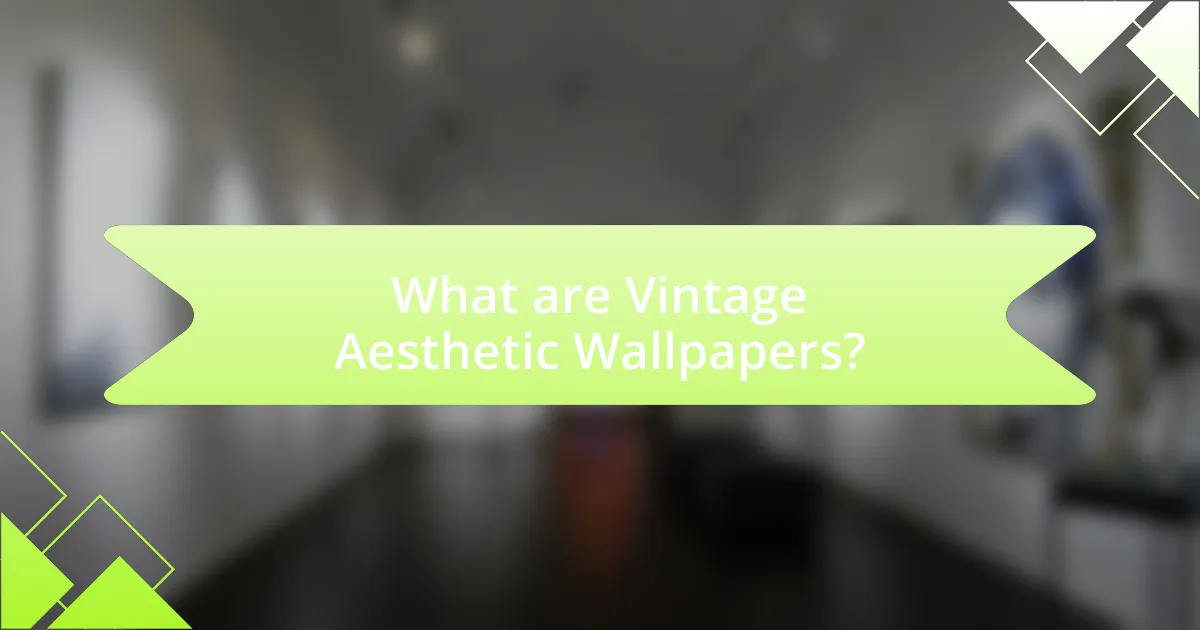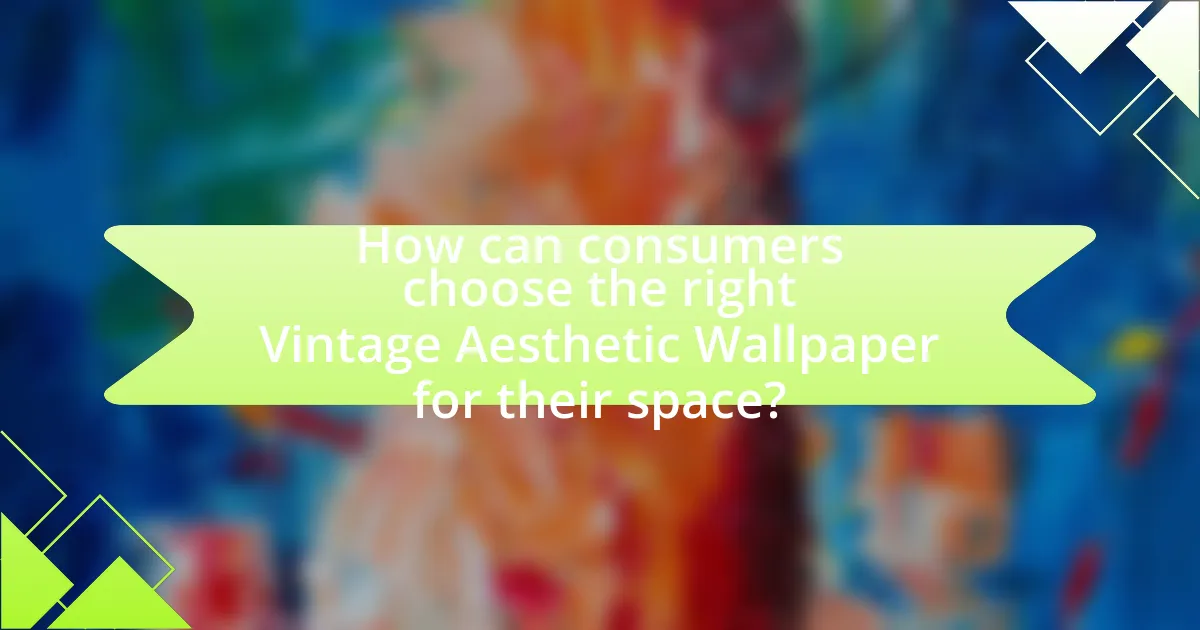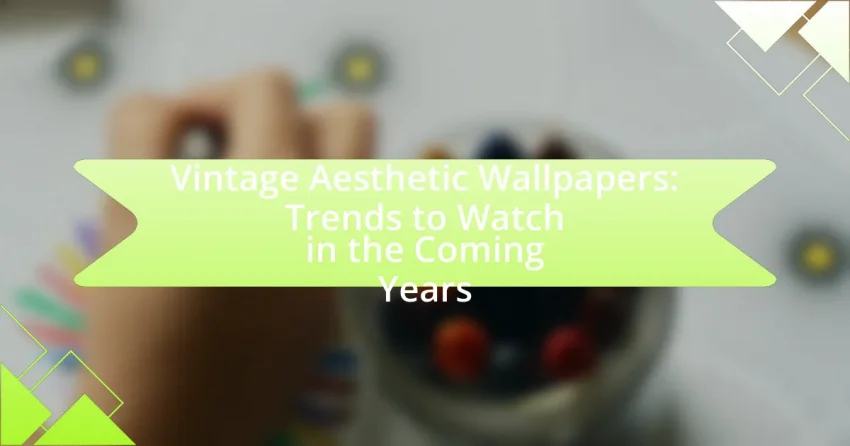Vintage aesthetic wallpapers are decorative wall coverings that draw inspiration from past artistic styles, primarily from the late 19th to mid-20th century, featuring floral patterns, geometric shapes, and muted color palettes. This article explores the differences between vintage and modern designs, the historical influences shaping these wallpapers, and the role of color palettes in creating nostalgic atmospheres. It also examines the growing popularity of vintage aesthetic wallpapers, driven by cultural trends and consumer preferences for unique home decor. Additionally, the article highlights key trends expected to dominate the market, innovative materials and techniques emerging in production, and practical tips for selecting, installing, and maintaining these wallpapers.

What are Vintage Aesthetic Wallpapers?
Vintage aesthetic wallpapers are decorative wall coverings that evoke a sense of nostalgia through designs inspired by past artistic styles, typically from the late 19th to mid-20th century. These wallpapers often feature floral patterns, geometric shapes, and muted color palettes that reflect historical design trends. The resurgence of interest in vintage aesthetics is supported by a growing consumer preference for unique, character-rich home decor, as evidenced by the increasing popularity of retro-themed interior design in recent years.
How do Vintage Aesthetic Wallpapers differ from modern designs?
Vintage aesthetic wallpapers differ from modern designs primarily in their color palettes, patterns, and overall themes. Vintage wallpapers often feature muted, earthy tones and intricate, nostalgic patterns inspired by historical art movements, such as Art Deco or Victorian styles. In contrast, modern designs typically embrace bold colors, minimalistic patterns, and contemporary themes that reflect current design trends, such as geometric shapes or abstract art. The historical context of vintage wallpapers, which often draws from specific cultural or artistic periods, contrasts sharply with the more universal and versatile approach of modern wallpaper designs, which prioritize functionality and simplicity.
What historical influences shape Vintage Aesthetic Wallpapers?
Vintage aesthetic wallpapers are shaped by historical influences such as the Arts and Crafts Movement, Art Nouveau, and mid-20th century design trends. The Arts and Crafts Movement, which emerged in the late 19th century, emphasized handcrafted quality and natural motifs, leading to wallpapers featuring floral and organic patterns. Art Nouveau, popular from the 1890s to the early 1900s, introduced flowing lines and intricate designs, influencing wallpaper styles with its emphasis on beauty and nature. Additionally, mid-20th century design trends, particularly the retro styles of the 1950s and 1960s, brought bold colors and geometric patterns, further enriching the vintage aesthetic. These historical movements collectively contribute to the nostalgic and artistic qualities found in contemporary vintage aesthetic wallpapers.
How do color palettes play a role in Vintage Aesthetic Wallpapers?
Color palettes are essential in defining the mood and style of Vintage Aesthetic Wallpapers. They typically feature muted, earthy tones, pastel shades, and soft contrasts that evoke nostalgia and a sense of timelessness. Historical design trends, such as the use of colors from the 1960s and 1970s, influence these palettes, creating a visual connection to the past. For instance, colors like faded teal, mustard yellow, and soft pink are commonly used to reflect vintage themes, enhancing the overall aesthetic appeal. This strategic use of color not only attracts consumers seeking a retro vibe but also reinforces the emotional resonance associated with vintage design.
Why are Vintage Aesthetic Wallpapers gaining popularity?
Vintage aesthetic wallpapers are gaining popularity due to a growing desire for nostalgia and unique home decor that reflects personal style. This trend is driven by consumers seeking to create warm, inviting spaces that evoke memories of the past, as well as a reaction against the minimalism of modern design. According to a report by the Interior Design Society, vintage styles have seen a resurgence, with a 30% increase in searches for retro and vintage-themed home decor items over the past two years. This indicates a clear consumer preference for designs that offer character and history, making vintage aesthetic wallpapers a favored choice in contemporary interior design.
What cultural trends are driving the resurgence of Vintage Aesthetic Wallpapers?
The resurgence of Vintage Aesthetic Wallpapers is primarily driven by a growing interest in nostalgia and retro design among consumers. This trend reflects a cultural shift towards valuing authenticity and individuality in home decor, as people seek to create personalized spaces that evoke memories of the past. Additionally, the rise of social media platforms, particularly Instagram and Pinterest, has facilitated the sharing of vintage-inspired aesthetics, making these wallpapers more visible and desirable. The popularity of DIY home improvement projects during the pandemic has further fueled this trend, as individuals look for unique ways to enhance their living environments.
How do Vintage Aesthetic Wallpapers enhance interior design?
Vintage aesthetic wallpapers enhance interior design by adding character and a sense of nostalgia to spaces. These wallpapers often feature intricate patterns, muted colors, and historical motifs that evoke a specific era, creating a unique atmosphere. For instance, studies show that incorporating vintage elements can increase emotional well-being and comfort in a home environment, as they often remind individuals of cherished memories or styles. Additionally, vintage wallpapers can serve as focal points in a room, drawing attention and providing a backdrop for modern furnishings, thus blending old and new design elements seamlessly.

What are the key trends in Vintage Aesthetic Wallpapers for the coming years?
Key trends in Vintage Aesthetic Wallpapers for the coming years include a resurgence of botanical patterns, muted color palettes, and the incorporation of retro textures. Botanical designs, inspired by nature, are gaining popularity as they evoke a sense of tranquility and connection to the outdoors. Muted color palettes, featuring soft pastels and earthy tones, are being favored for their ability to create calming environments. Additionally, retro textures such as linen and fabric-like finishes are being utilized to enhance the tactile experience of wallpapers, reflecting a desire for authenticity and nostalgia in interior design. These trends align with consumer preferences for sustainable and artisanal products, as evidenced by a growing market for eco-friendly wallpaper options.
Which styles are expected to dominate the Vintage Aesthetic Wallpaper market?
Floral patterns and retro geometric designs are expected to dominate the Vintage Aesthetic Wallpaper market. These styles resonate with consumers seeking nostalgia and a connection to past eras, particularly the mid-20th century. The resurgence of interest in vintage aesthetics is supported by market research indicating a growing preference for home decor that reflects personal history and unique character, with floral motifs and geometric shapes being particularly popular due to their timeless appeal and versatility in various interior settings.
What role does nostalgia play in the popularity of these styles?
Nostalgia significantly enhances the popularity of vintage aesthetic wallpapers by evoking emotional connections to the past. This emotional resonance often leads consumers to seek out designs that remind them of their childhood or significant cultural moments, thereby driving demand. For instance, research indicates that nostalgia can increase consumer preference for products associated with positive memories, as shown in studies published in the Journal of Consumer Research, which highlight how nostalgic feelings can influence purchasing behavior. Consequently, the appeal of vintage styles is rooted in their ability to transport individuals back to simpler times, making them more desirable in contemporary interior design.
How are contemporary artists influencing Vintage Aesthetic Wallpaper designs?
Contemporary artists are influencing Vintage Aesthetic Wallpaper designs by integrating modern techniques and themes into traditional patterns. This fusion results in wallpapers that maintain the nostalgic charm of vintage designs while incorporating contemporary color palettes, textures, and motifs. For instance, artists often utilize digital printing technology to recreate intricate vintage patterns with a fresh twist, making them more appealing to modern consumers. Additionally, the resurgence of interest in retro styles has led artists to reinterpret classic designs, blending them with current artistic trends such as minimalism or abstract art. This evolution reflects a broader trend in interior design where vintage aesthetics are revitalized through contemporary artistic expression, ensuring their relevance in today’s market.
What materials and techniques are emerging in Vintage Aesthetic Wallpapers?
Emerging materials in Vintage Aesthetic Wallpapers include eco-friendly options such as recycled paper and natural fibers like hemp and linen. These materials are gaining popularity due to their sustainability and aesthetic appeal. Techniques such as digital printing and hand-painted designs are also on the rise, allowing for intricate patterns and customization that reflect vintage styles while meeting modern demands. The combination of these materials and techniques enhances the authenticity and visual richness of vintage aesthetic wallpapers, catering to contemporary interior design trends.
How do sustainable practices impact the production of Vintage Aesthetic Wallpapers?
Sustainable practices significantly enhance the production of Vintage Aesthetic Wallpapers by promoting eco-friendly materials and processes. Manufacturers increasingly utilize recycled paper and non-toxic inks, reducing environmental impact while maintaining the vintage aesthetic. For instance, a study by the Sustainable Furnishings Council indicates that using water-based inks can lower harmful emissions by up to 90%. Additionally, sustainable sourcing of raw materials ensures that the production aligns with environmental conservation efforts, appealing to eco-conscious consumers. This shift not only preserves the vintage charm but also aligns with modern sustainability trends, making these wallpapers more attractive in the market.
What innovative printing techniques are being used for these wallpapers?
Innovative printing techniques used for vintage aesthetic wallpapers include digital printing, which allows for high-resolution designs and intricate patterns, and eco-friendly inkjet printing, which utilizes water-based inks to reduce environmental impact. Digital printing enables customization and rapid production, making it ideal for unique vintage designs. Eco-friendly inkjet printing not only minimizes harmful emissions but also supports sustainable practices in wallpaper production. These techniques are increasingly adopted in the industry, reflecting a shift towards both creativity and environmental responsibility in wallpaper design.

How can consumers choose the right Vintage Aesthetic Wallpaper for their space?
Consumers can choose the right Vintage Aesthetic Wallpaper for their space by considering the overall theme and color palette of their room. Selecting wallpaper that complements existing furniture and decor enhances the vintage aesthetic, as colors and patterns should harmonize with the space’s style. For instance, floral patterns or muted tones often evoke a vintage feel, aligning with trends from the 1960s and 1970s, which are currently popular. Additionally, consumers should assess the wallpaper’s material and texture, as options like vinyl or fabric can impact the room’s ambiance. Research indicates that vintage designs can increase a home’s appeal, making thoughtful selection crucial for achieving the desired aesthetic.
What factors should be considered when selecting Vintage Aesthetic Wallpapers?
When selecting Vintage Aesthetic Wallpapers, consider the design style, color palette, material quality, and historical context. The design style should align with the overall aesthetic of the space, whether it be Art Deco, Victorian, or Mid-Century Modern. The color palette must complement existing decor, as vintage wallpapers often feature muted tones or intricate patterns that can enhance a room’s ambiance. Material quality is crucial; wallpapers made from durable materials like vinyl or fabric can ensure longevity and ease of maintenance. Lastly, understanding the historical context of the wallpaper can add authenticity and depth to the decor, as certain patterns and styles are emblematic of specific eras.
How do lighting and room size affect the choice of wallpaper?
Lighting and room size significantly influence the choice of wallpaper by affecting color perception and pattern visibility. In well-lit rooms, lighter colors and bold patterns can enhance the space, making it feel larger and more inviting. Conversely, in dimly lit areas, darker shades and subtle patterns may be preferred to create a cozy atmosphere. Research indicates that natural light can alter the appearance of colors, with studies showing that colors can appear up to 30% different under various lighting conditions. Additionally, smaller rooms benefit from wallpapers with vertical stripes or light colors to create an illusion of height and space, while larger rooms can accommodate more intricate designs without overwhelming the area.
What are the best color combinations for Vintage Aesthetic Wallpapers?
The best color combinations for Vintage Aesthetic Wallpapers include muted pastels, earthy tones, and rich jewel colors. Specifically, combinations like dusty rose with sage green, mustard yellow with deep teal, and soft lavender with warm beige evoke a nostalgic feel. These color palettes are rooted in historical design trends from the mid-20th century, reflecting a preference for softer, more subdued hues that create a cozy and inviting atmosphere. The use of these combinations can be traced back to vintage interior design styles, which often emphasized harmony and warmth, making them ideal for vintage aesthetic wallpapers.
What tips can help in the installation and maintenance of Vintage Aesthetic Wallpapers?
To successfully install and maintain Vintage Aesthetic Wallpapers, ensure that the wall surface is clean, dry, and smooth before application. This preparation prevents bubbles and peeling, which are common issues with wallpaper. Use a high-quality adhesive specifically designed for wallpaper to enhance durability and longevity. For maintenance, regularly dust the wallpaper with a soft cloth to prevent dirt buildup, and avoid using harsh chemicals that can damage the vintage patterns. If stains occur, gently clean with a damp cloth and mild soap, testing in an inconspicuous area first. These practices help preserve the aesthetic appeal and integrity of vintage wallpapers over time.
How can one prepare a wall for Vintage Aesthetic Wallpaper application?
To prepare a wall for Vintage Aesthetic Wallpaper application, one must first clean the wall thoroughly to remove dust, dirt, and grease. This ensures proper adhesion of the wallpaper. Next, any holes or imperfections should be filled with spackle or joint compound, and the surface should be sanded smooth once dry. After that, applying a primer suitable for wallpaper is essential, as it enhances adhesion and prevents moisture damage. Finally, ensure the wall is completely dry before proceeding with the wallpaper application. These steps are crucial because a well-prepared wall significantly increases the longevity and appearance of the wallpaper.
What are the best practices for cleaning and maintaining these wallpapers?
The best practices for cleaning and maintaining vintage aesthetic wallpapers include using a soft, dry cloth for dusting, avoiding excessive moisture, and using gentle cleaning solutions when necessary. Regular dusting prevents dirt buildup, while excessive moisture can damage the wallpaper’s integrity. For stains, a mixture of mild soap and water applied with a soft cloth can effectively clean without harming the surface. Additionally, it is essential to test any cleaning solution on a small, inconspicuous area first to ensure it does not cause discoloration or damage. These practices help preserve the wallpaper’s appearance and longevity, ensuring it remains a beautiful feature in any space.
